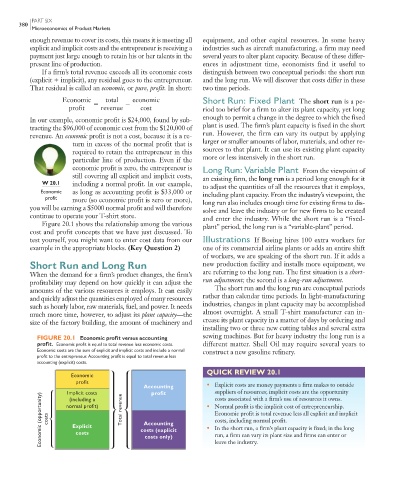Page 448 - Economics
P. 448
CONFIRMING PAGES
PART SIX
380
Microeconomics of Product Markets
enough revenue to cover its costs, this means it is meeting all equipment, and other capital resources. In some heavy
explicit and implicit costs and the entrepreneur is receiving a industries such as aircraft manufacturing, a firm may need
payment just large enough to retain his or her talents in the several years to alter plant capacity. Because of these differ-
present line of production. ences in adjustment time, economists find it useful to
If a firm’s total revenue exceeds all its economic costs distinguish between two conceptual periods: the short run
(explicit implicit), any residual goes to the entrepreneur. and the long run. We will discover that costs differ in these
That residual is called an economic, or pure, profit. In short: two time periods.
Economic total economic Short Run: Fixed Plant The short run is a pe-
profit revenue cost riod too brief for a firm to alter its plant capacity, yet long
In our example, economic profit is $24,000, found by sub- enough to permit a change in the degree to which the fixed
tracting the $96,000 of economic cost from the $120,000 of plant is used. The firm’s plant capacity is fixed in the short
revenue. An economic profit is not a cost, because it is a re- run. However, the firm can vary its output by applying
turn in excess of the normal profit that is larger or smaller amounts of labor, materials, and other re-
required to retain the entrepreneur in this sources to that plant. It can use its existing plant capacity
particular line of production. Even if the more or less intensively in the short run.
economic profit is zero, the entrepreneur is Long Run: Variable Plant From the viewpoint of
still covering all explicit and implicit costs, an existing firm, the long run is a period long enough for it
W 20.1 including a normal profit. In our example, to adjust the quantities of all the resources that it employs,
Economic as long as accounting profit is $33,000 or including plant capacity. From the industry’s viewpoint, the
profit more (so economic profit is zero or more), long run also includes enough time for existing firms to dis-
you will be earning a $5000 normal profit and will therefore solve and leave the industry or for new firms to be created
continue to operate your T-shirt store. and enter the industry. While the short run is a “fixed-
Figure 20.1 shows the relationship among the various plant” period, the long run is a “variable-plant” period.
cost and profit concepts that we have just discussed. To
test yourself, you might want to enter cost data from our Illustrations If Boeing hires 100 extra workers for
example in the appropriate blocks. (Key Question 2) one of its commercial airline plants or adds an entire shift
of workers, we are speaking of the short run. If it adds a
Short Run and Long Run new production facility and installs more equipment, we
When the demand for a firm’s product changes, the firm’s are referring to the long run. The first situation is a short-
profitability may depend on how quickly it can adjust the run adjustment; the second is a long-run adjustment.
amounts of the various resources it employs. It can easily The short run and the long run are conceptual periods
and quickly adjust the quantities employed of many resources rather than calendar time periods. In light-manufacturing
such as hourly labor, raw materials, fuel, and power. It needs industries, changes in plant capacity may be accomplished
much more time, however, to adjust its plant capacity—the almost overnight. A small T-shirt manufacturer can in-
size of the factory building, the amount of machinery and crease its plant capacity in a matter of days by ordering and
installing two or three new cutting tables and several extra
sewing machines. But for heavy industry the long run is a
FIGURE 20.1 Economic profit versus accounting
profit. Economic profit is equal to total revenue less economic costs. different matter. Shell Oil may require several years to
Economic costs are the sum of explicit and implicit costs and include a normal construct a new gasoline refinery.
profit to the entrepreneur. Accounting profit is equal to total revenue less
accounting (explicit) costs.
QUICK REVIEW 20.1
Economic
profit
Accounting • Explicit costs are money payments a firm makes to outside
suppliers of resources; implicit costs are the opportunity
Economic (opportunity) costs normal profit) Total revenue costs (explicit • Normal profit is the implicit cost of entrepreneurship.
Implicit costs
profit
costs associated with a firm’s use of resources it owns.
(including a
Economic profit is total revenue less all explicit and implicit
costs, including normal profit.
Accounting
Explicit
• In the short run, a firm’s plant capacity is fixed; in the long
costs
run, a firm can vary its plant size and firms can enter or
costs only)
leave the industry.
9/7/06 3:42:25 PM
mcc26632_ch20_378-398.indd 380 9/7/06 3:42:25 PM
mcc26632_ch20_378-398.indd 380

